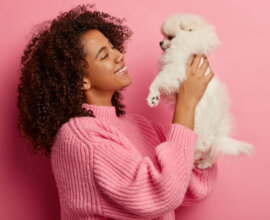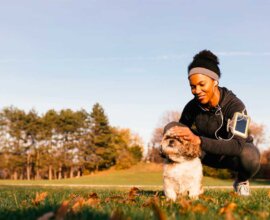How Can I Keep My Dog Calm and Relaxes When I Leave the Home?
While most of us would probably prefer to stay at home with our beloved pets, leaving the house is necessary. Whether it’s going to work, going grocery shopping, or simply socializing, there will come a time when your dog must stay home alone.
Separation anxiety is incredibly common among dogs, and this can make it difficult to justify leaving them.
Luckily, there are plenty of solutions. In this article, we’ll look at ways to keep your dog calm and relaxed when you leave home.
Signs of Stress in Dogs
Before looking at solutions, it’s worth covering the key signs of stress in dogs. After all, you might think your dog is fine just because they’re not bouncing off the walls or crying when you go out.
The most obvious signs of stress in dogs include:
- Barking and whining
- Pacing
- Shaking
- Having accidents in the house
- Ears pinned back against the head
- Tail between its legs
- Hiding or intentionally being in the way
Most of these are fairly easy to spot, especially if your dog is otherwise friendly and lively. More nuanced signs of stress include panting and scratching themselves.
If left untreated, stress in dogs can lead to weight loss, loss of appetite, shedding, and aggressive behavior.
You may already think your dog is stressed. When it comes to leaving the house, stress and anxiety become quite obvious in dogs.
How to Deal with Separation Stress
Before trying to solve the problem, it’s worth looking into why your dog might get stressed when you leave the house.
For most dogs, it simply boils down to the fact that they don’t know when (or if) you’ll come back. As we can’t explain that we’re only leaving for a short time, it’s understandable that they might think they’ve been abandoned.
Does your dog have much experience being left alone? If not, training is the most obvious solution. But if you’ve owned them for a while and this has always been a problem, you might have to consider other solutions.
Separation anxiety can also be triggered by traumatic experiences, such as going to a boarding kennel. It’s a common issue with rescue dogs, particularly those that weren’t treated very well.
So, providing the problem isn’t too severe, here are some options for keeping your dog calm when you leave the house.
Build up its Tolerance
The most obvious solution is training. Simply leave the house for a few minutes and then return. Don’t make a massive fuss of the dog; pet them and say hello.
Gradually build up the length of time you’re away from the house. For the first week or so, just leave through the front door and stay outside. Then, as you build it up, you can actually start going places.
While this might not be the easiest solution if you have to go to work, a common problem with separation anxiety is dogs being dropped in at the deep end. Going from constant human contact to being alone for 8 hours can be quite shocking.
Building up separation time is designed to make it clear that you will return, regardless of how long you’re out for.
Create a Signal Word
Another helpful tip is to give your dog a signal word that you’re leaving that indicates you’ll come home. Much like training them to sit or stay, this simply associates an action with a noise so they know how to react.
As with training commands, it should be short and said every time. Something like “bye” or “2 minutes” is ideal.
Make the Process Seem Minor
When leaving the house, don’t make a big fuss of your dog. Use a word, as suggested above, and then just leave.
The same goes for when you come home. Come in, say hello, and then give it a few minutes before you pet them.
This should help them realize that you leaving the house really isn’t a big deal. Consider adding this into the tolerance routine suggested above.
Create a Safe Space
Again, this works on the idea of conditioning. By creating a space that’s calm, and is where they’re left every time, you’re teaching the dog a routine. This helps to prevent stress because they know what to anticipate.
The best option is a room that can be sealed off from the rest of the house. It should have windows, a place for them to sleep, and access to a water bowl. Of course, interactive toys will help too.
Ideally, use a room that doesn’t face your front door. This should prevent the stressful behavior of sitting at the window waiting. If your dog is essentially cut off from your front door, they should just get on with things.
The jury’s out on whether crating is good for this. While some people see crates as a bit cruel, this isn’t the case. A suitable crate should always be big enough for the dog to stand up and lie down with ease. There should also be room for a water bowl.
With some training, most dogs will be perfectly happy in a crate. But, it’s perhaps not ideal for separation anxiety. This is because a stressed dog might try to escape the crate and injure itself.
Leave Some of Your Clothes Around
Clothes that smell like you can do a great job of calming a dog down. Consider leaving an old t-shirt in their bed. Ideally, it should be unwashed so it smells like you rather than laundry detergent.
This is a really simple trick that doesn’t prevent separation anxiety but at least gives the dog a familiar scent to calm it down.
Conclusion
Keeping your dog calm when you leave the house requires patience and training. The more you build an obvious routine around you going out, the better your dog should cope.
Of course, if separation anxiety continues to be a problem, speak to your vet to see if they have any solutions.






